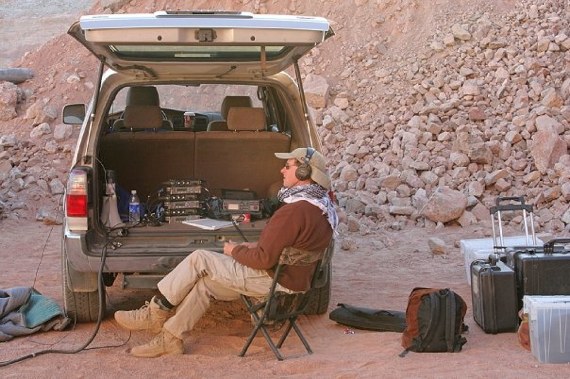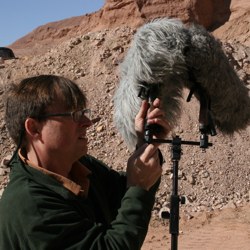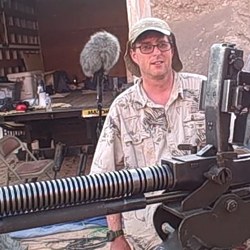
Let’s get started with the Charles Maynes Special. I interviewed him about the general aspects of his career, his tools, workflow, creativity techniques, and more. If you want to ask something to Charles, please go here.
Designing Sound: Please give us a general overview of your career. How do you get started with sound? How was your first gig like?
Charles Maynes: I actually got started with the digital sampling revolution back in the early 80’s. I was massively effected in particular by an interview with Peter Gabriel that was done for the “South Bank” show on the BBC – I saw a video of him breaking things and making funny noises with the Fairlight CMI- so with that, I saved and borrowed money to purchase an Emu Systems Emulator II (back then it was about eight thousand dollars- a lot of money for a 20 year old musician!) I started making sounds with it and got to record some pretty neat things- like some of the Harry Partch Instruments at San Diego State University. I also started working for the shop that sold me the Emulator, I guess because I was working with it so much. While I was at that shop, which is now Professional Sound and Music in San Diego California, I had the opportunity to work on my first film and meet a long time collaborator Martin Lopez who is still doing outstanding design work now in Hollywood. At the the time, he was doing the sound for a San Diego cult film franchise’s second installment- “Return of the Killer Tomatoes”. Martin was cutting all the sound on mag film and recording effects on a Nagra analog recorder came into the shop to see if we could help him with some of the more crazy design sounds. It was an extremely low budget affair- (As I recall, I think he paid me about $200 dollars) but I did end up getting to meet one of the stars for whom I was an enormous fan of, the original Gomez Addams, John Aston. I have to say that encounter was about the coolest thing ever! Another star of the film was an up and coming actor who is now fairly well known, a very young George Clooney.
So from there, I also was making sample sounds for the Emulator which were sold by Emu Systems and a company called Optical Media which did the very first CD-ROM sample libraries. I ended up in the 90’s working for a company that split from them called Invision Interactive that also did sample sounds for both samplers and hardware sythesizers and had the great fortune of crossing paths with Marc Farly who now works for SCEA in the Bay Area. Marc at the time was a young guy, but probably was one of the most singularly impressive people (along with sound editor Jamie Hardt) who I have had the pleasure of working with and become friends with.
From Invision I moved to working at Digidesign about a year before ProTools hit the market, spending time first in the their Customer Support department and then in the Software testing department. Digi had so many notably wonderful people at the time that it would be boring for me to go on and on about the experience. Those were truly good times at Digi, I did sort of gravitate to the post production end of the product line, and ended up meeting a few people in Hollywood who encouraged me to make a jump to film sound. In particular, Rob Sephton at Disney and Randy Thom were tireless in putting up with me. Then at Universal, Harry Snodgrass actually took me in and helped me find my way in film sound, so you can blame him for everything… I have since been at this endeavor since around 1995 and could not think of a better job in the world!
DS: Did you have a mentor early in your career? Someone you admire?
CM: The most influential person has to be Gary Rydstrom, I am a disciple of his work. Randy Thom as well, he is just a wonderfully generous man. Randy has probably shared more wisdom with me than anyone else and I treasure the kindness he has shown. Other folks who had a big influence on me were Steve Flick who snapped me up as and imparted me with the big budget film soundtrack mentality and the precious people he had working for him at the time. Specifically, Warren Hamilton, Marvin Walowitz, Chuck Smith, Greg Hedgepath, David Yewdall, Dave Stone and Bill Jacobs. I owe them so much that I will never be able to pay.
I think guys like Dane Davis and Ren Klyce have done some extraordinary work as well. As to inspirational sources- I love history- so there is no end of inspirational figures to draw upon there. One particular guy I have unending admiration of though is Jay Wilkinson. Next to Warren Hamilton, I consider him to probably be one of the most under appreciated sound editors in the history of the craft.
DS: You’ve been working in this industry for more than 15 years… How have you seen the evolution of the industry/technology since then? Is there something you miss from those days?
CM: When I came into the Industry ProTools was just getting established as a tool for this job so it hasnt changes that radically. The biggest change has been the generally crew downsizing that the increasing power of computers is bringing to the job.
DS: What do you like about being a sound designer?
CM: I love field recording the most. I just like being outside and trying to capture the excitement of the physical world and to be able to create new sounds with those recordings.
DS: What are the main tools you work with?
CM: In the Studio- ProTools and Soundminer. I spend about 99% of time using those two applications. I also love using sample based manipulation tools which I’ve been leaning on the program “Keymap Pro” by Redmatica. I dont really use sampling so much in the Pro Tools environment, but I do use both Structure and Kontakt from time to time. As for plugins, there are so many that I cant really think of any true “desert Island” ones because they all can be irreplaceable depending on the task. My particular favorites though would have to be the Sonnox plugins, the Eventide Anthology package and McDSP plugins. I do also like GRM Tools, Sound Toys “Sound Blender” plugins and anything Steve Massey makes.
In the field – Sound Devices 744’s and almost any microphone you can think of.
DS: How do you dealt with bad sound design/mixing moments? When you’re working on a sound/ scene, and it doesn’t work was well as you want. What do you do in those moments?
CM: For me, it is sort of a holisitic process. Ideally you have music that is being used or at least a general sense of how the music is going to be used. Probably one of the more challenging things I have had to come up with was for the film “The Fantastic Four” the sound for Sue Storm being able to disappear was very elusive and to my utter astonishment we used a very early design piece that was developed for it. Quiet or subtle sounds like that tend to be the most difficult I think. As what is desired, it really depends on the visuals. Usually there is some sort of metaphor which can be pulled from the image to imply a sonic approach. I personally tend to not favor heavily processed sounds though, so I like to try to spend some time thinking through allegorical sound approaches to the problem. I have personally found that intuitive approaches seem to be more satisfying in those moments.
DS: You’ve worked on films, tv, and video games. If you had to choose just one industry to exclusively work for, which would you go with and why?
CM: I think i would tend to lean towards film since it is a “big idea” sort of format. The one exception I can think of was working with Sound Supervisor Ben Cook on “The Pacific” which was sort of like 5 feature films. As to why a film is unique that way, you have to tell the story in a relatively short, single sitting. With a game and a TV series you can redefine the world somewhat easily and episodically. That is not easily managed in films.

DS: You’ve worked on lots of different genres and styles, do you have a favorite? Are you interested on a specific challenges for the future?
CM: I love doing military themed films and games. I guess because it is so much fun trying to live up to the expectations of the audience. As to future challenges… that is hard to gauge. Just keeping employed seems to be a big enough challenge over the last few years.
DS: What is the best advice you can give to a sound designer? (both young and experienced)
CM: Make it your passion. The thing I always ask is “would you do this if you weren’t getting paid for it” if the answer is yes- then you are ready to get to work. The passion though is what I see to be the driving function. People like Charles Deenen and Jay Wilkinson are like that (many more too) we often turn off the money clock and spend long nights making our best work, not so much for the clients benefit, but so that we are satisfied with what we present to the client.
DS: What are your favorite sounds to create/record?
CM: I like doing gun sounds and I love ambiences. One of the films I am quite proud of was “Tuck Everlasting” which was a period piece set in early 20th century Mayrland. The forest sequences were wonderful to design.
DS: When and how do you typically find yourself at the most creative?
CM: I like quiet…. so I personally feel my most insightful work will happen when not much is going on around me. Most times that is late at night. As to workflow, I actually try to conform to the people I am working with. Everyone has preferences and I not into making a fuss. For creative decisions, I rely a lot on my intuition and I have probably done far more charity work than I should have, but thats just a part of life I guess.

DS: In the book “Practical Art of Motion Picture Sound” David Lewis Yewdall talks about you and your work. He gives you as an example of a sound effects editor working on his home, with his own stuff, using tools such as DigiDelivery, etc. Do you still working with this freelance position? Why do you like to work in this way?
CM: As far as working freelance, I think it is a great thing especially to be able to specialize in stuff I think is rewarding and a challenge to create sounds for- unfortunately it can sometimes work against you though in the sense that one, you get pigeon-holed- for instance even after doing sound editorial for 15 years, there are some people who think I only record effects…. The other downside is that people in the industry can sometimes assume that because you aren’t around all the time- They might assume you are already busy (because you havent been in touch. or even that you are simply too expensive to hire for the work)- something that I have certainly run into more than a few times. The other thing that is pretty neat about being independent though is that you can take on projects which strike your fancy without impacting the people you might typically work with. I guess for me sometimes it has been great, and sometimes it has created financial hardship.
DS: I see you’re very active in social sites and forums such as Gearslutz Forum, Facebook, commenting on blogs, etc. How important is networking for a sound designer? What do you think about the great online community that has been evolving in the last years?
CM: I like to participate in the exchange of ideas and the musician in me loves Gearslutz- Jules also tracked and recorded Siouxsie and the Banshee’s awesome single “Cities in Dust” which is one of my all time favorite rock songs. Regarding networking I think as a freelancer it is very important… I have sort of become one of the leading weapons recordists currently working (42 weapons recording sessions so far…) so it is nice to make sure people have access to me for work and what not. I have a pretty wide net of clients which covers the globe who hire me for recording and design which is sort of neat too. Facebook is an interesting phenomenon as well. I think what Chuck has done with his fan page is a good idea because a personal page cant really serve as a professional billboard without getting cluttered up by things that are largely irrelevant to your work. So all in it is only good. Instant Messaging allows one to stay in nearly immediate touch your associates.

DS: What do you think about projects such as Tim Prebble’s HISS and a ROAR and Chuck Russom FX? Would you like to sell your own sound effects on your own label?
CM: I think they are great. I am still not certain how well they will work out on the long run but the ideas behind both Chuck and Tim’s sites are really cool. I am actually going to be participating in the door library Tim is putting together, that should be a wonderful thing. As to doing producing my own libraries, I am on the fence. I already have associations with Sound Ideas, Hollywood Edge, Blastwave and Sound Dogs so I have a fair amount of sounds out there already. Doing a private label would require an unknown investment of time and effort, and at the present I would be reluctant to guess how much interest there would be. I do a fair amount of custom library work for Bangolia Music as well.
DS: Is there something you would want to see in the the industry’s future?
CM: That is something I cannot even guess. I would like to see the industry thrive though and us as craftsmen and women be able to be afforded the consideration to contribute in a way which truly elevates the experience.
DS: What’s next for Charles Maynes?
CM: I am recording Ospreys with the Marines soon, beyond that, I can never guess what I will be called to do next….

[…] you have the opportunity to do your own questions Charles Maynes. Please read the exclusive interview first. Maybe you can find your answer there. There are several ways to make your […]